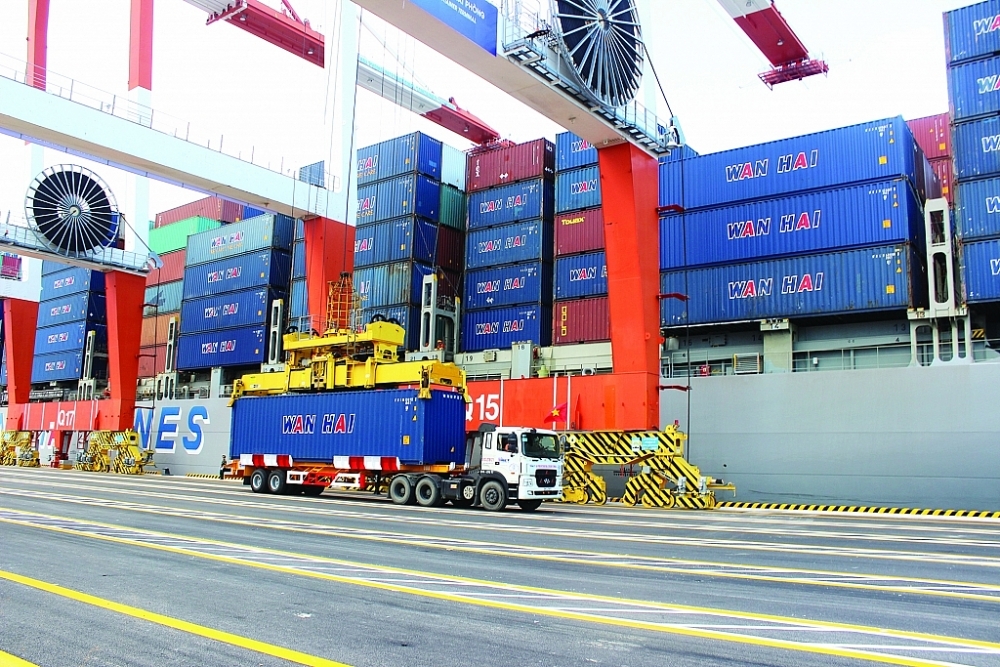Breaking the "monopoly" of road transportation
 |
| Photo: Thai Binh |
High road transportation costs
As a company with a factory located in Binh Duong province, about 30km from Cat Lai port, Nguyen Hong Thuy, Head of Import-Export Department of Vinh Nghia Shoes Company said Vinh Nghia Shoes Company took an average of two hours to bring goods to the port at a cost of VND2.7-3.2 million per container.
During peak hours, it takes 5-6 hours to deliver the goods to the port and bring empty containers back to the company, which increases costs by about 15%.
Additionally, the current shortage of empty containers from shipping lines leads to delays in delivery. Firms have to pay rent for empty containers ranging from several hundred thousand to several million VND.
Huynh Chi Dan, Director of Tam Lap Thanh Company specializing in transit goods to Cambodia, said the company carried out import and export of about 1,000-1,200 containers of goods monthly.
With a route of about 100km from Ho Chi Minh City to the Moc Bai border gate (Tay Ninh), a company spends about VND7-7.5 million per container, accounting for 70% of the shipment cost.
In which, the service cost at Cat Lai port is about VND1.4 million, the rest is tolls and fuel costs.
Moreover, traffic congestion on the way to Cat Lai port raises logistics costs for businesses. For example, if a company arrives at the port to receive their goods in the morning, but due to traffic jams or congestion at the port, their goods arrive at Moc Bai border gate the next day, they need to pay VND1 million more per container.
Luu Thi Minh Hien, Director of Hai Minh Company, one of the major logistics enterprises operating in the Southeast region, said that too many road toll stations led to an increase in business’ transport costs. Besides, the National Highway 51 from Vung Tau to Dong Nai is always congested, leading to the fact that business’ vehicles cannot turn around fast, pushing costs up.
Talking about the factors of logistics service costs, Pham Thi Thuy Van, Deputy Head of Marketing Department of Saigon Newport Corporation, said transport was the most important economic activity in the logistics service chain, accounting for about a third to two thirds of the enterprises’ logistics costs. That is because of Vietnam’s asynchronous transport infrastructure and weak connectivity between provinces and regions. Moreover, the fact that businesses only focus on transporting goods by road instead of other types such as waterways and aviation also increases the pressure on the road system, causing traffic congestion.
Strengthen inland waterway transportation
According to experts, to reduce logistics costs, the fundamental solution is to promote water transport connecting inland ports near factories, and to develop ICD and Depot with waterway connections in key economic zones. The advantages of these solutions are a stable and unrestricted barge route when entering the loading areas, large volume of shipping containers (from 36-96 TEUs), and a few vehicle operators needed (3- 4 people).
Phan Van Co, Marketing Director of Vrice Co., Ltd said most rice exporting companies in the Mekong Delta were using inland waterways instead of roads to save costs and increase competitiveness for their goods. The cost of using barges across the waterway from ports in Ho Chi Minh City to Thot Not port is VND5.3-5.5 million per container, depending on packing specifications. Meanwhile, if using roads, it will double, hurting Vietnam’s goods competitiveness against foreign countries.
VAS Steel An Hung Tuong Limited Liability Company, headquartered in Binh Duong, has also selected waterways as the main transport route to transport imported goods from ports in Ba Ria - Vung Tau to Binh Duong to save costs. Tran Quoc Toan, Head of Logistics Department of this company, said the average volume of transport of each barge is equivalent to 50 cars on the road, while the cost for each barge trip is only equivalent to about 15 car trips. Thus, there is a huge cost difference between the two types of transport.
Despite the low cost, according to Co, water transport from Ho Chi Minh City to the Mekong Delta provinces is facing major obstacles in the dry season due to low water levels, and barges through estuaries is dependent on tides. That is because the waterway transport system has been greatly degraded. In recent years, transportation companies have exploited it based on the available natural conditions without improving or investing.
Additionally, not all businesses can conveniently access the waterway transport method. Thanks to the location close to the banks of the Dong Nai River and investment in a private jetty system for loading and unloading goods, this business can save significantly their costs.
Although owning a factory located in Binh Duong, Lam Viet JSC does not have a convenient location to access waterways. With about 200 containers of wooden furniture exported per month, Nguyen Liem, Chairman of Lam Viet Company, said the competitiveness of Vietnamese goods is significantly affected due to the much higher cost of domestic transportation. To overcome this situation, Liem said solutions to utilize river and railway transport should be proposed to reduce the load on roads because these are two transport modes that have much lower costs.
According to enterprises, it is necessary to open empty depots and ICDs with waterway connections in the areas with a lot of goods (such as Can Tho, the Mekong Delta, and Binh Duong). They can load and unload goods at points near their factory to save transportation costs and protect the environment. Simultaneously, there should be a solution to plan ports for barges and inland ships next to major ports to optimize waterway transport.
The good exploitation of waterways and railways will increase connectivity from industrial zones in Binh Duong and Dong Nai to the port cluster in Cai Mep-Thi Vai area, thereby saving costs, increasing convenience for customers, and reducing the load for Tan Cang-Cat Lai Port.
Related News

Seaport enterprises accelerate seaport greening
09:15 | 15/12/2024 Import-Export

Logistics service businesses transform digitally to reduce costs
19:30 | 14/12/2024 Import-Export

Unit 4: Stopping dozens of cases of transportation in counterfeits through border gates
13:45 | 23/10/2024 Anti-Smuggling

Businesses reduce costs by complying with customs laws
09:18 | 11/10/2024 Customs
Latest News

Việt Nam tightens fruit inspections after warning from China
08:01 | 15/01/2025 Import-Export

Brand building key to elevate Vietnamese fruit and vegetable sector: experts
08:00 | 15/01/2025 Import-Export

Freight transport via China-Việt Nam cross-border trains posts rapid growth
08:01 | 13/01/2025 Import-Export

Vietnamese retail industry expects bright future ahead
06:22 | 11/01/2025 Import-Export
More News

Complying with regulations of each market for smooth fruit and vegetable exports
13:06 | 09/01/2025 Import-Export

Fruit and vegetable industry aims for $10 billion in exports by 2030
15:12 | 07/01/2025 Import-Export

GDP grows by over 7 per cent, exceeds target for 2024
15:11 | 07/01/2025 Import-Export

Vietnamese pepper: decline in volume, surge in value
15:10 | 07/01/2025 Import-Export

Việt Nam maintains position as RoK’s third largest trading partner
15:09 | 07/01/2025 Import-Export

Greater efforts to be made for stronger cooperation with European-American market
15:08 | 06/01/2025 Import-Export

Leather, footwear industry aims to gain export growth of 10% in 2025
15:06 | 06/01/2025 Import-Export

Grasping the green transformation trend - A survival opportunity for Vietnamese Enterprises
14:53 | 06/01/2025 Import-Export

Việt Nam to complete database of five domestic manufacturing industries in 2026
20:57 | 05/01/2025 Import-Export
Your care

Việt Nam tightens fruit inspections after warning from China
08:01 | 15/01/2025 Import-Export

Brand building key to elevate Vietnamese fruit and vegetable sector: experts
08:00 | 15/01/2025 Import-Export

Freight transport via China-Việt Nam cross-border trains posts rapid growth
08:01 | 13/01/2025 Import-Export

Vietnamese retail industry expects bright future ahead
06:22 | 11/01/2025 Import-Export

Complying with regulations of each market for smooth fruit and vegetable exports
13:06 | 09/01/2025 Import-Export
